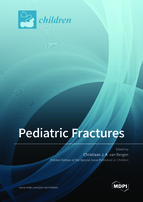Pediatric Fractures
A special issue of Children (ISSN 2227-9067). This special issue belongs to the section "Pediatric Orthopedics".
Deadline for manuscript submissions: closed (15 May 2022) | Viewed by 78702
Special Issue Editor
2. Department of Orthopedic Surgery and Sports Medicine, Erasmus University Medical Center – Sophia Children’s Hospital, Rotterdam, P.O. Box 2040, 3000 CA Rotterdam, The Netherlands
Interests: pediatric orthopedics; fractures; trauma; cartilage; sports
Special Issues, Collections and Topics in MDPI journals
Special Issue Information
Dear Colleagues,
Fractures are extremely common in children. The fracture risk in boys is 40% and 28% in girls. Although many pediatric fractures are frequently regarded as “innocent” or “forgiving”, typical complications do occur in this precious population, e.g., premature physeal closure and post-traumatic deformity, which may cause life-long disability.
Despite the high incidence of pediatric injuries, there is still much debate on optimal treatment regimes. Although non-operative and surgical treatment techniques have developed enormously during the past decades, current management is still more eminence-based rather than evidence-based because of the limited scientific evidence. For example, the recently developed comprehensive Dutch clinical practice guideline on diagnosis and treatment of the most common pediatric fractures included almost solely “low” or “very low” level recommendations, based on the Grading of Recommendations Assessment, Development, and Evaluation (GRADE) criteria. The only exceptions were some forearm fracture recommendations, which received “moderate” GRADEs. There is a clear lack of data and a need for higher-level science in pediatric trauma.
The main goal of this Special Issue of Children is to help fill the gap of undiscovered knowledge and improve the scientific understanding of pediatric fractures. Authors are invited to contribute to this Special Issue with original papers and reviews on all aspects related to pediatric fractures, including the diagnosis, treatment, or follow-up of common fractures. Authors are also encouraged to submit papers on specific pediatric injuries, as well as vulnerable populations such as children with bone disease. We also welcome articles that discuss important advancements and novel interventions on closely related topics, including high-energy trauma, perioperative care, and complication management.
Dr. Christiaan J. A. van Bergen
Guest Editor
Manuscript Submission Information
Manuscripts should be submitted online at www.mdpi.com by registering and logging in to this website. Once you are registered, click here to go to the submission form. Manuscripts can be submitted until the deadline. All submissions that pass pre-check are peer-reviewed. Accepted papers will be published continuously in the journal (as soon as accepted) and will be listed together on the special issue website. Research articles, review articles as well as short communications are invited. For planned papers, a title and short abstract (about 100 words) can be sent to the Editorial Office for announcement on this website.
Submitted manuscripts should not have been published previously, nor be under consideration for publication elsewhere (except conference proceedings papers). All manuscripts are thoroughly refereed through a single-blind peer-review process. A guide for authors and other relevant information for submission of manuscripts is available on the Instructions for Authors page. Children is an international peer-reviewed open access monthly journal published by MDPI.
Please visit the Instructions for Authors page before submitting a manuscript. The Article Processing Charge (APC) for publication in this open access journal is 2400 CHF (Swiss Francs). Submitted papers should be well formatted and use good English. Authors may use MDPI's English editing service prior to publication or during author revisions.
Keywords
- Pediatric orthopedics
- Fracture
- Trauma
- Injury
- Children
- Adolescents







